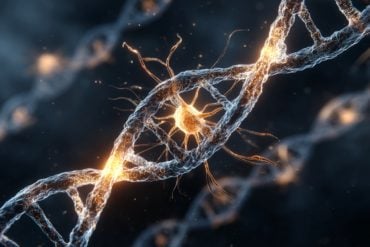Summary: Teens who engage in “transcendent thinking” can counteract the negative effects of violence exposure on brain development. This type of thinking involves considering broader ethical and societal implications of social issues.
The study showed that such reflective thinking leads to brain growth even in teens from high-violence communities. These findings emphasize the importance of fostering reflective thinking skills in adolescents.
Key Facts:
- Transcendent Thinking: Helps teens counteract negative brain effects from violence.
- Brain Growth: Reflective thinking promotes growth in areas affected by violence.
- Study Findings: Teens engaging in deeper thought show greater brain resilience.
Source: USC
These latest findings from CANDLE (USC Center for Affective Neuroscience, Development, Learning and Education) researchers show that teens who think about social issues and violence in more reflective ways show greater resilience to the effects of violence exposure on their brain development.
The study was published in the Journal of Research on Adolescence.
Mary Helen Immordino-Yang and a team of CANDLE researchers have found that teens who engage in more “transcendent thinking,” that is thinking that moves beyond reacting to the specifics of social situations to also consider broader ethical, personal and societal implications, can counteract the negative impacts exposure to violence has on their brain development.

The study built on an earlier one by Immordino-Yang that showed the disturbing link between adolescents’ exposure to violence in their community and their brain development.
In both studies, MRI brain scans of teens who grew up in communities with high levels of violence showed thinner cortex in parts of the brain that are involved in feeling stress and pain as well as motivation, judgment and emotional processing.
This new study confirms these links exist even in older teens, around age 16–18 when they witness violence, but also offers a possible antidote. The 55 participants were all from low socioeconomic status backgrounds and lived in urban settings. The teens were asked about their exposure to community violence and underwent two MRI brain scans, one at the beginning of the study and one two years later.
At the time of the initial scans, participants also watched mini-documentaries about teens in compelling situations and discussed their reactions in a recorded interview which was later assessed for transcendent thinking.
The final MRI scans showed that the more a teen had engaged in transcendent thinking, the greater the brain growth in various areas across the two years, including those areas most impacted by the violence.
The findings suggest that teens’ transcendent thinking may be helping them to counteract the effect of exposure to violence on their brain development.
These findings reveal that as adolescents work to contextualize and make sense of the violence they are exposed to, this complex thinking builds resilience and thus grows their brains despite the violence they witness.
When the teens were able to reflect on such things as why violence happens and what can be done to get to the root of the problems, they showed a form of neural resilience in their anterior cingulate cortex, among other regions.
“Let me be clear—we found that witnessing community violence and crime, even in older teens, was associated with key regions of their brain losing volume over time. In effect, witnessing violence made regions of their brains shrink a bit, which is a pattern seen in people suffering from PTSD and in soldiers deployed to war,” said Immordino-Yang.
“At the same time, the kids were not passively being impacted—when they showed us that they were thinking hard about why these things happen, and what could be done to make the world better for everyone involved, this kind of thinking grew their brain volume in these same brain regions. Violence was bad for them, but transcendent and civically oriented thinking was a kind of antidote, neurologically speaking.”
The study builds on a body of research spearheaded by Immordino-Yang that investigates the effects of transcendent thinking on adolescent brain development. A recent landmark study published by Immordino-Yang showed that transcendent thinking in adolescents can predict future brain growth and that this brain growth, in turn, predicts life satisfaction when youth transition to adulthood.
Immordino-Yang’s team’s findings underline the vulnerability of adolescents in communities impacted by high levels of violence while also emphasizing the importance of fostering skills like transcendent thinking in teens.
These skills cannot only help teens make sense of the violence they witness but also help them counteract the negative impact of this violence on their developing brains.
About this neurodevelopment and psychology research news
Author: Kianoosh Hashemzadeh
Source: USC
Contact: Kianoosh Hashemzadeh – USC
Image: The image is credited to Neuroscience News
Original Research: Open access.
“Transcendent thinking counteracts longitudinal effects of mid‐adolescent exposure to community violence in the anterior cingulate cortex” by Xiao‐Fei Yang et al. Journal of Research on Adolescence
Abstract
Transcendent thinking counteracts longitudinal effects of mid‐adolescent exposure to community violence in the anterior cingulate cortex
Adolescence involves extensive brain maturation, characterized by social sensitivity and emotional lability, that co-occurs with increased independence. Mid-adolescence is also a hallmark developmental stage when youths become motivated to reflect on the broader personal, ethical, and systems-level implications of happenings, a process we term transcendent thinking.
Here, we examine the confluence of these developmental processes to ask, from a transdisciplinary perspective, how might community violence exposure (CVE) impact brain development during mid-adolescence, and how might youths’ dispositions for transcendent thinking be protective?
Fifty-five low-SES urban youth with no history of delinquency (32 female; 27 Latinx, 28 East Asian) reported their CVE and underwent structural MRI first at age 14–18, and again 2 years later.
At the study’s start, participants also discussed their feelings about 40 minidocumentaries featuring other teens’ compelling situations in a 2-h private interview that was transcribed and coded for transcendent thinking.
Controlling for CVE and brain structure at the start: (1) New CVE during the 2-year inter-scan interval was associated with greater gray matter volume (GMV) reduction over that interval in the anterior cingulate cortex (ACC), a central network hub whose reduced volume has been associated with posttraumatic stress disorder, and across multiple additional cortical and subcortical regions; (2) participants’ transcendent thinking in the interview independently predicted greater GMV increase during the 2-year inter-scan interval in the ACC.
Findings highlight the continued vulnerability of mid-adolescents to community violence and the importance of supporting teens’ dispositions to reflect on the complex personal and systems-level implications and affordances of their civic landscape.






